MGMT 3123 Exam 1
Intro to OB
What is Organizational Behavior?
An Interdisciplinary field dedicated to understanding and managing people at work.
- It is a combination of anthropology, economics, ethics, management, political science, psychology, sociology, and statistics
What is an organization?
- A system of two or more people brought together to accomplish purposes not achievable through the efforts of individuals working alone (Ben & Jerry’s)
Importance of Research in OB: Intuition vs. Systematic Study
- Intuition = “gut feeling” explanation
- Based on observation, anecdotes
- Feels like common sense
- Can be useful but it is incomplete
- EX: two heads better than one or too many cooks spoil the broth
- Systematic study
- Complements intuition by testing alternative explanations
- Controls for things that can influence outcomes
- Organizational context, individual traits, team processes, etc.
- Allows managers to more accurately predict future behavior
Why OB matters
- It matters because it’s all about things you care about
- Getting a great job
- Getting along with others
- Managing up, managing down
- Making more effective decisions
- Staying motivated at work
- And so much more!
- Learning OB helps you become a more effective job candidate, employee, manager, and leader
Job Satisfaction and Commitment
Causes of behavior and attitudes at work
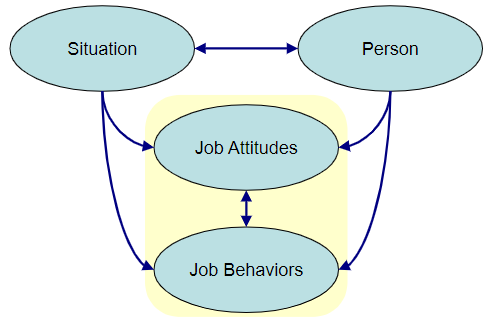
Job Attitudes
- Attitudes: our opinions, beliefs, and feelings about something specific
- Important attitudes to gauge at work
- Job satisfaction
- Organizational commitment
- Employee engagement
- Perceived organizational support
Job Satisfaction
Emotional response toward facets of a job
- Not monolithic - employees are not fully satisfied from factor like good work environment or pay
- Not static - Satisfaction changes with time (The Honeymoon-Hangover Effect)
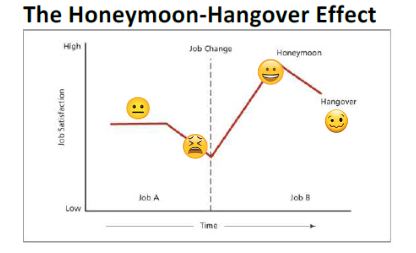
Job Satisfaction: Practical Research
- ~1/3 of JS determined by individual factors
- Trait affect - People with a more negative affect will have lower JS than those with positive affects
- Agreeableness - people who are more agreeable are more likely to have higher JS
- Self-esteem
- Growth mindset (vs fixed) - those with a growth mindset are more likely to have higher JS
- Takeaway: Understand your employees’ baseline JS and try to improve from there
Major Job Attitudes: Organizational Commitment
- Extent to which an individual identifies with an organization and commits to its goals
- Three Dimensions
- Affective - emotional attachment to the organization (attachment to a sports team)
- Continuance - economic value of staying (contracts or future pay if you continue to stay)
- Normative - moral or ethical obligation (work benefits the community)
Attitude-Performance Connection
Do positive hob attitudes predict greater job performance? Why or why not?
- Research shows weak correlation between JS and performance (.3 or less)
- Attitudes are best at predicting behavior via intentions
- Employee ability and other organizational behaviors may hinder performances
What are the outcomes of positive job attitudes?
Job Satisfaction and Organizational Commitment → Productivity/Efficiency, OCBs/CWB, Absenteeism, Turnover, Firm-level Outcomes
Going beyond job requirements: OCBs vs CWBs
OCBs (organizational citizenship behaviors)
- Discretionary behavior that promotes effective functioning of organization
- EX: Helping train or mentor, speaking up with constructive ideas, maintaining company property, being punctual
- GREAT for organizations
CWBs (Counterproductive work behaviors)
- Voluntary behavior that violates organizational norms and threatens the organization and its members
- EX: Stealing, gossiping, bullying, excessive tardiness, harassment
- BAD for organizations
Hirschman’s EVLN Model: Responses to Dissatisfaction
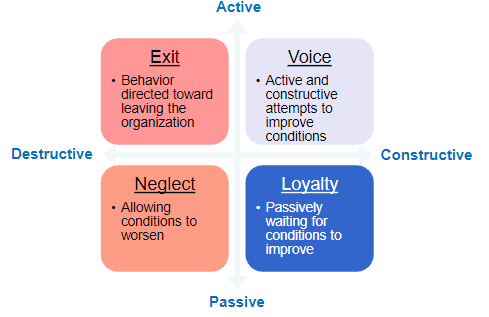
What predicts positive job attitudes? How can I improve employee attitudes?
Personality, Person-job Fit, Job Characteristics, Organizational Justice, Work Relationships, Stress, Work-life Balance→ Job Satisfaction and Organizational Commitment
You can’t buy satisfaction
- Pay may only influence job satisfaction to a point
- Until ~$75K/year in the US for individuals
- Boosts in pay may only lead to temporary increases in JS
Focus on the workplace
Key organization and job characteristics drive employee satisfaction
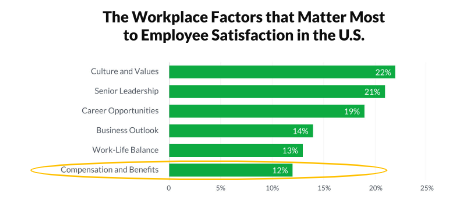
What if you’re stuck at a bad job?
- You are a dedicated and hard worker… but you hate your job and have low job satisfaction
- There’s a disconnect between your attitudes and behavior
- What do people do when behaviors and attitudes don’t align?
- Cognitive Dissonance occurs
Theory of Cognitive Dissonance
- Festinger’s theory of cognitive dissonance
- Describes psychological discomfort one experiences when holding conflicting attitudes and behaviors
- Dissonance = inconsistency
- People try to reduce dissonance to reach stability and consistency
Reducing Cognitive Dissonance
- 3 ways to decrease dissonance
- Changing the attitudes
- Modifying the behaviors
- Rationalization
- EX: A smoker finds out that smoking leads to cancer. How do they reduce dissonance?
Summary & Managerial Implications
- Job satisfaction is not only a function of pay, but a rather complex attitude from several different personal and work related factors
- Your attitudes influence important work outcomes, including performance
- Despite the evidence of the impact of job satisfaction on the bottom line, most managers are either unconcerned about or overestimate worker satisfaction
- It’s a good idea to measure these attitudes
- But remember, if you measure it, be ready to act on it
Personality and Values
Individual Difference
- Demographics: Distinct population categories, like age, gender, race
- Intelligence: An individual’s capacity for constructive thinking, reasoning, and problem solving
- Values: Abstract ideas that guide our thinking and behavior across all situations
- Personality: Set of traits, characteristics, and predispositions of a person
Why do personality and values matter at work?
- Both affect job selection, work attitudes, and work behaviors
- Understanding your personality and values will help you understand:
- Where do I fit? In what context will I excel?
- How do I interact effectively with others?
- What do I need to develop?
To categorize or not to categorize?
Many personality assessments available. EX: MBTI vs. Big 5 Model
Myers-Briggs Type Indicator (MBTI)
- Identifies 8 personality preferences: 4 pairs of opposites
| Dimension | Explanation | |
|---|---|---|
| EI: Energy Source | Extraversion: Those who derive their energy from other people and objects | Introversion: Those who derive their energy from inside |
| SN: Gather Info | Sensing: Those who rely on their five sense to perceive the external environment | Intuition: Those who rely on their intuition and hunches to perceive the external environment |
| TF: Make Decisions | Thinking: Those who use their logic to arrive at solutions | Feeling: Those who use their values and ideas about what is right and wrong to arrive at solutions |
| JP: Preferred Lifestyle | Judgement: Those who are organized, systematic and would like to have clarity and closure | Perception: Those who are curious, open minded, and prefer to have some ambiguity |
“Big Five” Personality Dimensions
| Trait | Description |
|---|---|
| Openness | Curious, original, intellectual, creative, and open to new ideas |
| Conscientiousness | Organized, systematic, punctual, achievement-oriented, dependable |
| Extraversion | Outgoing, talkative, sociable, and enjoys being in social situations |
| Agreeableness | Nice, tolerant, sensitive, trusting, kind, warm |
| Neuroticism/Emotional Stability | Anxious, irritable, aggressive, temperamental, and moody |
To remember the traits of the Big 5 personality traits think O.C.E.A.N.
Openness to Experience
- The extent to which someone seeks new experiences and is tolerant of change (creativity)
| Low | HIGH | ||
|---|---|---|---|
| Imagination | Implements plans | Creates and implements equally | Creates new plans and ideas |
| Complexity | Prefers simplicity | Balance of simplicity and complexity | Seeks complexity |
| Change | Wants to maintain existing methods | Is somewhat accepting of changes | Readily accepts changes and innovations |
| Scope | Attentive to details | Attends to details if needed | Prefers a broad view and resists details |
Conscientiousness
- How an individual approaches goals (achievement-oriented)
| Low | High | ||
|---|---|---|---|
| Perfectionism | Low need to continually refine or polish | Occasional need to refine or polish | Continual need to refine or polish |
| Organization | Comfortable with little formal organization | Maintains some organization | Keeps everything organized |
| Drive | Satisfied with current level of achievement | Needs some additional achievement | Craves even more achievement |
| Concentration | Shifts easily between on-going tasks | Can shift between tasks before completion | Prefers completing tasks before shifting |
| Methodical | Operates in a more spontaneous mode | Does some planning | Develops plans for everything |
Extraversion
- The degree to which a person can tolerate sensory stimulation from people and situations (assertiveness)
| Low | High | ||
|---|---|---|---|
| Enthusiasm | Holds down positive feelings | Demonstrates some positive feelings | Shows a lot of positive feelings |
| Sociability | Prefers working alone | Occasionally seeks out other | Prefers working with others |
| Energy Mode | Prefers being still in one place | Maintains a moderate activity level | Prefers to be physically active |
| Taking charge | Prefers being independent of others | Accepts some responsibility for others | Enjoys responsibility of leading others |
| Trust of Others | Skeptical of others | Is somewhat trusting | Readily trusts others |
| Tact | Speaks without regard for consequences | Exerts moderate care in selecting words | Carefully selects the right words |
Agreeableness
- The degree to which we take other’s opinions into account (self-monitoring)
| Low | High | ||
|---|---|---|---|
| Service | More interested in self needs | Interested in needs of others and self | More interested in others’ needs |
| Agreement | Welcomes engagement | Seeks resolution | Seeks harmony |
| Deference | Wants acknowledgement | Likes some acknowledgement | Uncomfortable with acknowledgement |
| Reserve | Usually expresses opinions | Expresses opinions somewhat | Keeps opinions to self |
| Reticence | Enjoys being out front | Wants some visibility | Prefers the background |
Emotional Stability (reverse of Neuroticism)
- How we respond to stress/negative experiences (anxiousness)
| Low | High | ||
|---|---|---|---|
| Sensitiveness | Worrying | Some concern from time to time | At ease most of the time |
| Intensity | Quick to feel anger | Occasionally heated | Usually calm |
| Interpretation | Pessimistic explanations | Realistic explanations | Optimistic explanations |
| Rebound Time | Longer rebound time | Moderate rebound time | Rapid rebound time |
Big 5 vs MBTI
- Distributions
- By forcing people into one group or another it disrupts the normal distribution where most people remain in the middle
- Test - retest reliability
- Big 5 is more reliable (e.g., consistent)
- Predictive power
- Big 5 → more accurate outcome predications (e.g., performance and leader effectiveness)
- Less prevalent in pop culture
Personality and Performance
Effect of personality on performance in various situations
| High independence | Social Skills required | Frequent interaction w/ angry people | High level of competition required | High level of creativity required | |
|---|---|---|---|---|---|
| Openness | + | + | |||
| Conscientious | + | + | |||
| Extraversion | + | + | + | ||
| Agreeable | + | + | - | ||
| Need for stability | - | - |
- Effects on turnover
- High Openness to experience → higher turnover
- High Agreeableness → lower turnover
Other Individual Differences
- Proactive personality
- How willing am I to enact change to my environment?
- Self-concept
- Locus of Control - internal vs. external
- Self-Esteem: how much do I like myself?
- Self-Efficacy: how capable do I think I am at stuff?
- Self-Monitoring: how aware am I of myself?
Self-monitoring
- Regulating how you present yourself to match the demands of a social situation
- Typically influences performance through advantageous social positions
- Good social skills, conflict management
- Means high SMs are often chosen as friends and advice sources
- These “ties” provide intangible resources to high SMs, which results in performance and career success
Trait Affect
- Negative Affectivity
- Tendency to experience aversive emotional states
- Fear, hostility, anger
- Positive Affectivity
- Propensity to experience positive states
- Enthusiasm, confidence, cheerfulness
The Dark Side to Personality Tests?
- 80% of Fortune 500 companies use personality assessments for hiring
- Some pros vs. many cons
- Accuracy in predicting work performance mixed
- Reliability varies (demand characteristics)
- Discriminatory: racist, ableism, sexist, classist
TIP: Use them WITH other hiring/screening tools
Values
- Stable, abstract ideas that guide our thinking and behavior across all situations
- Values can be terminal or instrumental
- Terminal: what is the goal you value?
- Instrumental: what trait/action do you value?
Importance of Values
- Provide understanding of people’s attitudes, motivation, and behaviors
- Influence our perceptions
- Judgements of what is right vs. wrong
- Influence our priorities
- Job/organization selection
Personality and Values: Workplace Implications
- As an employee:
- Find a job and workplace that aligns with your values
- Understand your personal strengths/opportunity areas
- Assess your teammates’ personalities
- As a manager, be mindful when:
- Selecting employees
- Managing and training employees
- Creating effective workgroups
Stress and Emotions
Why do we care?
- Managing emotions at work is critical
- Important means of communicating with each other
- In service, it’s part of the job
- Prevalent issue with extremely high costs if ignored
Definitions
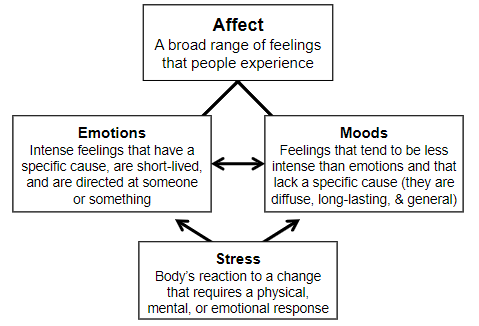
Some History: Emotions were ignored in OB
- The “myth of rationality” gave emotions research a late start (1980’s)
- Emotions seen as irrational (e.g., disruptive)
- Interfered with individual and organizational efficiency
- Focused only on negative emotions
- Researchers now agree: emotions cannot be separated from the workplace
- Employees use emotions to guide their decisions and behaviors
Emotions and Decision Making
- Emotions and your gut intuition
- Takeaway: Emotions…
- Are deeply connected to our memories
- Often provide critical data that guide our behavior unconsciously
What am I feeling?
- Researchers have identified six basic emotions:
- Happiness, surprise, fear, sadness, anger, disgust
- Moods can be positive or negative, high arousal (e.g., excited, upset) or low arousal (e.g., calm, bored)
Why do I feel this way?: Because of what happened at work
Affective events theory main points
- Work events cause positive or negative emotions
- Personality & mood determine the intensity of the emotions
- Emotions influence performance and satisfaction variables
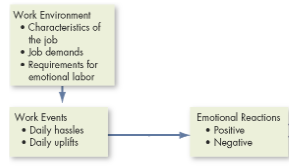
Why do I feel this way?: Because I’m stressed out!
- Subjective
- Cumulative
- Common Stressors
Stress Outcomes
Is all stress bad?
- Eustress vs. distress
- Hindrance vs. challenge stressors
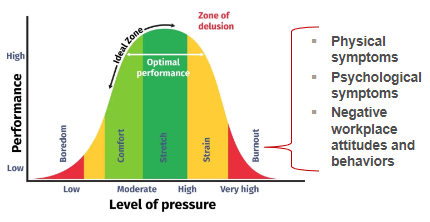
Another common source of work stress: Emotional labor
- Regulation of feelings and expressions for the organization
- Felt emotions often different from employees’ displayed emotions
How emotional laborious is my job?
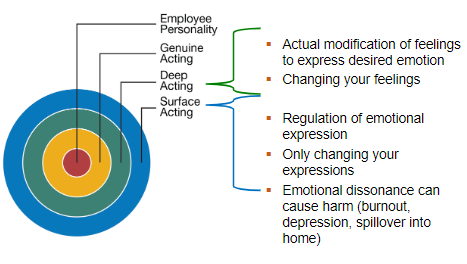
What can make emotional labor worse?: Emotional Contagion
- People are hard-wired to pick up emotional signals from others
- This affects behavior
- Ilies, Wagner & Morgeson (2007) study
- An individual’s affective state can be predicted from the average affective state of the group
Work Consequences of Emotions
- Positive emotions can be beneficial
- Increase creativity
- Increase OCBs
- Optimism and enthusiasm used to gain leadership status
- … but they can also impair decision-making
- Negative emotions can cause harm
- Increase CWBs
- Bottling up emotions is unsustainable → outbursts
Tips for coping with Emotional Labor
- Remind yourself why you’re in the job
- Reconnect with the larger purpose
- Explore “want to” thinking
- Reframe some aspects of your job as things you “want to” do vs. things you “have to” do
- Job craft
- Work with your manager on tweaking your job in a way that’s more aligned with your values
- Make time to decompress
- Have trusted friends you can open up to
- Take mental-health breaks
- Schedule emotionally taxing work with emotionally uplifting or neutral work
Tips for Managing Stress
- Complete the stress cycle
- Alarm, resistance, exhaustion
- Allow stress to leave the body
- Relaxation techniques
- Redirect from ruminating
- Healthy distractions
- Positive memories/experiences
- Focused journaling and mindfulness/meditation
- Lean on social support
Managerial Tips for Managing Emotions at Work
- Develop emotional intelligence (EI): understanding how others react to our emotions
- 5 components of Emotional Intelligence:
- Self-Awareness - Be aware of your emotion as they arise.
- Self-Regulation - Manage your impulses soothe yourself & respond appropriately.
- Self-Motivation - Delay gratification, stay motivated &persistent in face of setbacks.
- Empathy - Understand others’ feelings, needs, wants and concerns.
- Relationship Management - Manage others’ emotions, organize groups & negative solutions.
- High EI → increased well-being, decision-making, team performance, and reduced stress and turnover
Takeaways for Work
- Be aware of what emotions you take to work (and what you take back home!)
- If your job requires emotional labor, be aware of potential negative consequences
- Managers should be aware of their employees’ emotions, as well as their own
Theories of Motivation
What is Motivation?
Key Elements
- Direction: Toward beneficial goal
- Intensity: How hard a person tries
- Persistence: How long a person tries
Motivation = f(direction, intensity, persistence)
- Direction is Easy
- Intensity and persistence not so much
Intrinsic vs. Extrinsic Motivation
- Intrinsic Motivation
- being driven by positive feelings associated with doing well on a task or job
- Extrinsic Motivation
- motivation caused by the desire to attain specific outcomes
Theories of Motivation - Overview
- Content/Need-based
- Theory X v. Y (McGregor)
- Hierarchy of Needs (Maslow)
- Acquired Needs Theory (McClelland)
- Process-based
- Equity Theory
- Justice Theory
- Expectancy Theory
Theory X and Y (McGregor)
Theory X - A pessimistic view
- Assumptions
- People dislike work
- Monitoring is necessary
- Rewards and punishment critical to motivation
Theory Y - A positive view
- Assumptions
- People are self-engaged, responsible, creative
Abraham Maslow’s Hierarchy
Main argument: As each need becomes satisfied, the next need become dominant
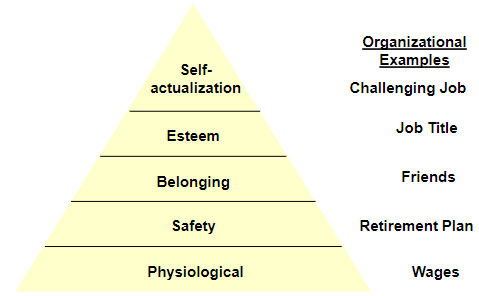
Acquired Needs Theory (McClelland)
- Main argument: People are motivated by certain needs to differing degrees
- Need for achievement (nAch)
- Need for power (nPow)
- Need for affiliation (nAff)
Self-Determination Theory (Deci, Ryan)
Main Argument: Innate needs must be satisfied for flourishing (intrinsic motivation)
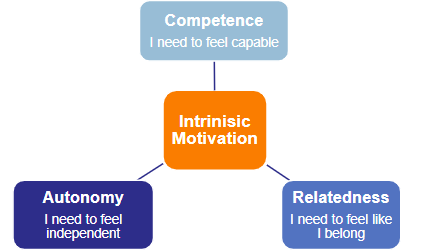
Takeaways from early theories
- Different employees have different needs
- Understanding employees' dominant needs to motivate better
Process-based Theory: Equity Theory
- Main argument: Individuals engage in comparisons of their job inputs and outcomes
| Self | Other | ||
|---|---|---|---|
| Equity | Outcomes/Inputs | = | Outcomes/Inputs |
| Positive Inequity | Outcomes/Inputs | > | Outcomes/Inputs |
| Negative Inequity | Outcomes/Inputs | < | Outcomes/Inputs |
| Inequity | Outcomes/Inputs | ≠ | Outcomes/Inputs |
Justice Theory
- Main argument: People are more motivated when they perceive that they are treated fairly
- Distributive - Perceived fairness of the way resources/rewards are allocated
- Procedural - Perceived fairness of the process and procedures used to make decisions
- Interactional - Quality of interpersonal treatment when procedures are implemented
Expectancy Theory
Main argument: People choose how to behave from alternative course of action, based on expectations of gains for each action
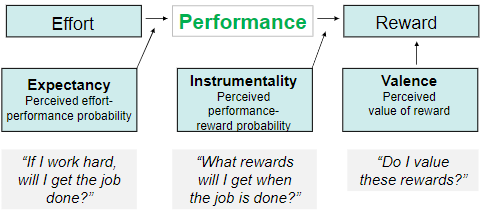
Expectancy Theory - Managerial Levers
Managers need to ensure that no part of the chain is broken
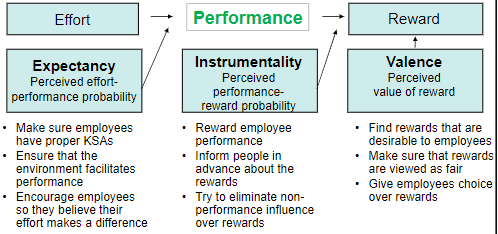
Takeaways from Process Theories
- Equity and fairness are very important to people
- They will attempt to get it on their own when faced with inequity
- Giving employees voice and an appeals process will enhance the justice climate and motivation
- People’s expectations are a powerful driver of motivated behavior
- Expectation that they can achieve the task
- Expectation that manager will reward them properly
- Employee perceptions matter
Pay for Performance - Lincoln Electric
Lincoln Electric uses a pay for performance system where they pay their employees based on how productive they’ve been.
- $ motivation is powerful, but matching overall strategy of the company is key
- Different pieces of the reward system must reinforce one another and be consistent
- Trust between management and employees is essential to the company’s success.
Evaluating Pay-for-Performance
| Pros: | Cons: |
|---|---|
| Quantifiable Criteria | Creates Competition |
| Measurable over time | Often hard to define & measure performance |
| Can compare to other employees | Not everyone values $ |
| $ generally valued | May be difficult to link performance & outcomes over a 1-year period |
| Could lead to perceived inequity | |
| Lose intrinsic motivation |
Pay-For-Performance Best Practices
- Keep system simple
- Provide clear & specific performance criteria
- Ensure employees have control over performance outcomes (effort → performance)
- Be objective! Differentiate between high & low performers, and do not factor in personal factors
Bottom Line: Make sure people have other reasons to perform well. Too much emphasis on $ is almost always destructive
SAS: The Original Happiness Machine
SAS provides many perks, benefits, and services, such as daycare and healthcare, to care for their employees needs outside of work to foster their cultural environment of creativity and innovation.
Evaluating SAS’ Ability to Motivate
| Pros: | Cons: |
|---|---|
| Perks/benefits can reduce stress | Is this a cult? |
| Autonomy and flexibility | “Velvet Handcuffs”: unsatisfied workers may overstay |
| Lots of social bonding | Homogenous culture can decrease innovation |
| Job security | Not everyone uses socialized benefits; could cause inequity |
Very different, yet… very similar?
- Similarities include:
- Care about productivity
- Care about employees (vs. execs/stockholders)
- Consistent, trusted leadership
- Attracts a specific type of person
- Reward system supports company’s strategy
- SAS - culture of creativity
- LE - high quality at lowest cost)
- Fair & transparent about benefits
- High autonomy
Lincoln & SAS Takeaways
- Effective motivation systems can be very different
- The many pieces to motivation must reinforce one another and be consistent
- Motivation systems must also be consistent with company strategy
- Trust between management and employees is essential
Motivating Through Job Design
- Job Design: Changing the content and/or process of a specific job to increase job satisfaction and performance
The Job Characteristics Model
Takeaway: Job characteristics can lead to serious psychological repercussions which ultimately affect performance and satisfaction
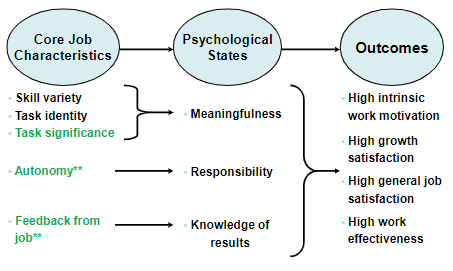
Job Design Strategies for Managers
- Enlargement: add more variety
- Rotation: move employees to other roles
- Enrichment: add more responsibility and authority
- Simplification: remove tasks to make work more focused
Job Design Strategy for YOU: Job Crafting
Employees can take initiative to shape characteristics of their job
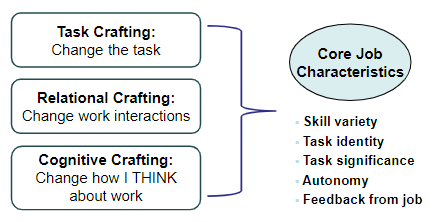
Benefits: More meaning, resilience, and enjoyment
Goal Setting Theory
- Objective: High motivation and task performance
- Why it works:
- Directs our attention
- Regulates effort
- Induces us to be persistent
- Discovery of effective strategies
Tips for making even better goals
- How vs why goals
- The way we word our goals may affect our motivation
- Are you motivated by chores or a sense of purpose
- Approach vs. avoidance goals
- Which motivated you more?
- Be mindful of psychological state parity
- Empathy gap → unrealistic goal
The Dark Side of Goals
Downsides of goals?
- Learning and adaptability decline
- Narrow thinking may develop (tunnel vision)
- Ethical problems increase
- Goal displacement
- Means become ends-in-themselves that displace the original goals
Takeaway: Be careful of what you measure and reward, and revise goals if necessary
Managerial Takeaway
- Reward systems are very complicated and should be carefully thought out
- Try to balance extrinsic (Pay for Performance) and intrinsic (Job Design and Goal-setting) motivation